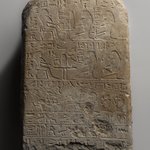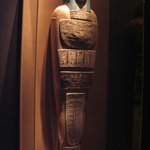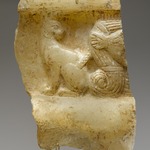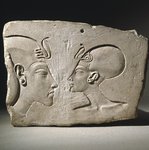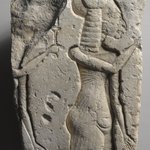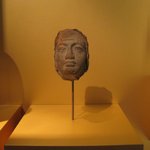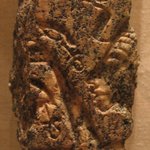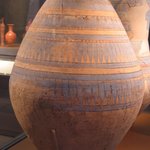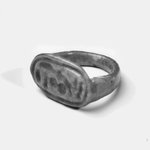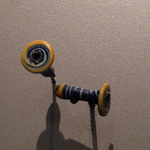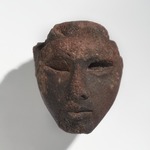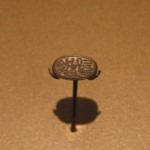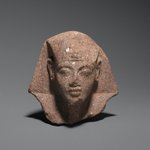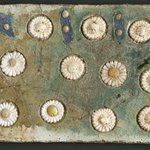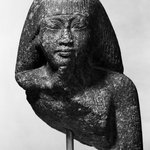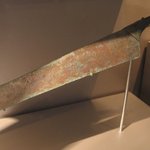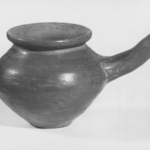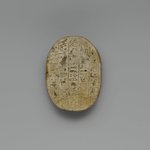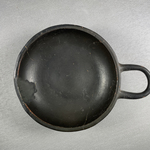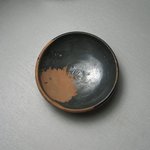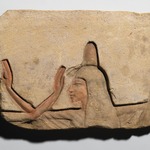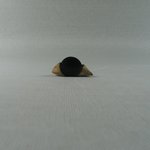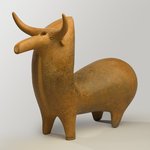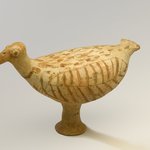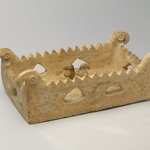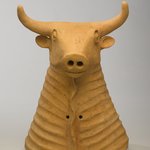

Inlay Profile Head, ca. 1353-1336 B.C.E. Red quartzite, pigment, 4 5/8 x 4 7/16 x 1 11/16 in. (11.8 x 11.2 x 4.3 cm). Brooklyn Museum, Gift of the Egypt Exploration Society, 33.685. Creative Commons-BY (Photo: Brooklyn Museum, 33.685_PS2.jpg)

Inlay Profile Head, ca. 1353-1336 B.C.E. Red quartzite, pigment, 4 5/8 x 4 7/16 x 1 11/16 in. (11.8 x 11.2 x 4.3 cm). Brooklyn Museum, Gift of the Egypt Exploration Society, 33.685. Creative Commons-BY (Photo: Brooklyn Museum, 33.685_NegA_bw_SL4.jpg)
Inlay Profile Head
Egyptian, Classical, Ancient Near Eastern Art
On View: Amarna Period, Martha A. and Robert S. Rubin Gallery, 3rd Floor
Composite sculpture, or sculpture that combines separately carved elements of different materials, became particularly popular during the Amarna Period. The face in profile was once embellished with the eye and eyebrow inlays made of glass or semiprecious stones. The crown as well as the rest of the body would have been carved from other stones.
MEDIUM
Red quartzite, pigment
DATES
ca. 1353-1336 B.C.E.
DYNASTY
late Dynasty 18
PERIOD
New Kingdom, Amarna Period
DIMENSIONS
4 5/8 x 4 7/16 x 1 11/16 in. (11.8 x 11.2 x 4.3 cm) (show scale)
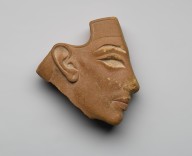


COLLECTIONS
Egyptian, Classical, Ancient Near Eastern Art
ACCESSION NUMBER
33.685
CREDIT LINE
Gift of the Egypt Exploration Society
PROVENANCE
Trench in the Great Temple at Tell el-Amarna, Egypt; 1932-33, excavated by John Devitt Stringfellow Pendlebury for the Egypt Exploration Society (excavation no. 32-33/61); 1933, gift of the Egypt Exploration Society to the Brooklyn Museum.
Provenance FAQ
CATALOGUE DESCRIPTION
Inlay profile head of red quartzite facing right, representing Akhenaten or Smenkhare, probably the former. Lips painted red.
Condition: Nose chipped. Eye, eyebrow and cheek slightly chipped. Minor scars. Lips painted red.
EXHIBITIONS
MUSEUM LOCATION
This item is on view in Amarna Period, Martha A. and Robert S. Rubin Gallery, 3rd Floor
CAPTION
Inlay Profile Head, ca. 1353-1336 B.C.E. Red quartzite, pigment, 4 5/8 x 4 7/16 x 1 11/16 in. (11.8 x 11.2 x 4.3 cm). Brooklyn Museum, Gift of the Egypt Exploration Society, 33.685. Creative Commons-BY (Photo: Brooklyn Museum, 33.685_PS2.jpg)
IMAGE
overall, 33.685_PS2.jpg. Brooklyn Museum photograph, 2008
"CUR" at the beginning of an image file name means that the image was created by a curatorial staff member. These study images may be digital point-and-shoot photographs, when we don\'t yet have high-quality studio photography, or they may be scans of older negatives, slides, or photographic prints, providing historical documentation of the object.
RIGHTS STATEMENT
Creative Commons-BY
You may download and use Brooklyn Museum images of this three-dimensional work in accordance with a Creative Commons license. Fair use, as understood under the United States Copyright Act, may also apply.
Please include caption information from this page and credit the Brooklyn Museum. If you need a high resolution file, please fill out our online application form (charges apply).
For further information about copyright, we recommend resources at the United States Library of Congress, Cornell University, Copyright and Cultural Institutions: Guidelines for U.S. Libraries, Archives, and Museums, and Copyright Watch.
For more information about the Museum's rights project, including how rights types are assigned, please see our blog posts on copyright.
If you have any information regarding this work and rights to it, please contact copyright@brooklynmuseum.org.
RECORD COMPLETENESS
Not every record you will find here is complete. More information is available for some works than for others, and some entries have been updated more recently. Records are frequently reviewed and revised, and we welcome any additional information you might have.





